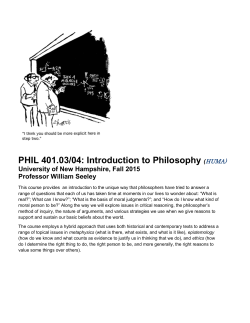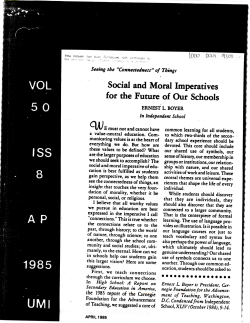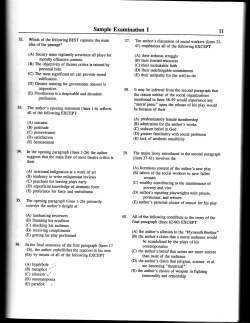
Panic Now!
Panic Now! Barry Glassner’s (1999) The Culture of Fear • Formerly a professor of Sociology at University of Southern California • Author of a number of articles and books on the culture of fear phenomenon Frank Furedi’s (2006) Culture of Fear Revisited • Professor of Sociology at the University of Kent, UK • Author of author of Politics of Fear, Where Have All the Intellectuals Gone?, Therapy Culture, Paranoid Parenting and Culture of Fear. The Social Construction of Reality • Peter Berger and Thomas Luckman, 1966 • Knowledge is derived from and maintained by social interaction • The meanings of anything are the product of human interpretations and are not in nature • Our understandings of the world are produced by us, are socially constructed Moral Panics • Stanley Cohen (1972) Folk Devils and Moral Panics: The Creation of the Mods and the Rockers • A study of subculture and the media’s role in defining social problems for the public Cohen’s Case Study • conflict between Mods and Rockers, in Clacton on Easter Sunday, 1964 • two groups fought resulting in some vandalism and property damange • In the end, 97 arrested Conclusions • the media's coverage of the episode was subject to exaggeration and distortion of the facts, giving the impression the event was more violent than it actually was The Media’s Role • An 'amplification' takes place through the media • It appeals to the public so that they concur with ready-made opinions about the course of action to be taken Moral Panics • Moral Panic, defined: “A condition, episode, person or group of persons emerges to become defined as a threat to societal values and interests” Social Control Moral panics function to support and legitimize particular kinds of social control through: 1) Identifying a “social problem”; 2) Simplifying its cause; 3) Stigmatizing those involved; 4) Stirring up public indignation or concern. Goode and Ben Yehuda (1994) Moral Panics: The Social Construction of Deviance • • • • • 1. Concern 2. Hostility 3. Consensus 4. Disproportionality 5. Volatility Glassner’s (1999) “Social Construction of Fear” • “Fear is constructed through efforts to protect against it.” • “Neither the things that people do to protect themselves individually or collectively, nor what they are protecting themselves from, necessarily reveal their true fears.” Misdirection • Like a magician’s sleight of hand to execute a magic trick, media work to focus our attention away from real risks and struggles • We are afraid of the wrong things because these are the things on the media agenda Erving Goffman (1974) Framing Theory • The ways that stories are framed influences the meaning they will have • Definitions of a situation are constructed in accordance with principles of organization which govern events and our subjective involvement in them Frames Defined • Frames are cognitive structures which guide perception and representations of reality • They structure which parts of reality get noticed • They are not necessarily consciously manufactured and are often unconsciously adopted Todd Gitlin’s (1980) definition • “Frames are principles of selection, emphasis and presentation composed of little tacit theories about what exists, what happens, and what matters.” • In sort, frames structure our attention Media Effects • What effects does our consumption of media have on our understandings of the world? Cultivation Theory – George Gerbner • TV viewing has quantitatively observable effects on the perceptual worlds of audiences • Watching violence on TV creates an exaggerated belief that the world is violent or, in his words, “mean and scary” The Hypodermic Model • Also known as the “Magic Bullet theory” • The passive audience is injected with ideas about the world by media Agenda Setting Theory McComb and Shaw • The agenda of the media and the public agenda are closely matched • The media’s agenda setting function means that there is a high correlation between media and the public ordering of priorities • People are more likely to attribute importance to and event, issue, or idea because of media exposure Risk Society – Ulrich Beck • Risk is a product of knowledges produced by people, generally experts in a variety of scientific disciplines and actuaries • Risk as what has not-yet happened but is probable or predicted • The perception of risk has changed as a result of science and the unboundedness of time and space Moral Panics Vs .... • Risk found in people • Risks are time limited and infinitely substitutable • Risks lead to scapegoating • Risks are created by media • Moral outrage is the outcome • Moral panics can create a culture of fear ...Vs Risk Society • Risk found in our environments • Risks are not bound to space and time • Risks are defined not for purposes of blame but for purposes of increased control • Risks are created by science and knowledge • Moral imperatives to risk aversion are the outcome • Risk knowledges can create a culture of fear Glassner “Why Americans are Afraid of the Wrong Things” Glassner’s examples: • Health scares • Killer kids • Crime • Others? • http://www.youtube.co m/watch?v=cYApo2d8o _A Why we are afraid: • Premillennial tensions • The news media • Alarmism • Psychological projection of personal, moral, etc. insecurities Why do we panic? • The dominance of an ethos of risk-aversion • Overreaction • Disproportionality • Others? • What gets defined as a panic and what not depends on who is doing the defining. • Political agendas and selectivity • Pedagogies of fear Technical explanations: • Media amplification or attenuation of risk • Most people get information by way of media • Fear sells Social explanations: • Change is experienced as risk • Concern about the future • Impossibility of knowing • Diminished humanity • Reconciling limits • All collect under the umbrella of the last theme: Diminished sense of control Workshop: Critical Reading • • • • • • Who? What? When? Where? Why? How? • Where did it come from? Who wrote it? When? • Who is it written for? • What does it say? What is its topic? Thesis? What evidence does it provide to support its argument? What examples does it use? • How is the argument organized? • Is there a bias? Of what it is trying to persuade you?
© Copyright 2025





















